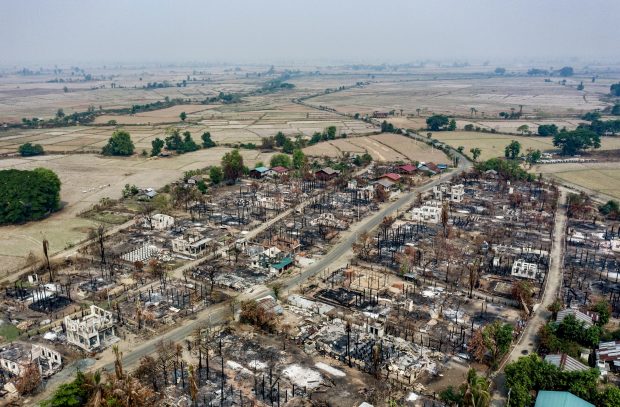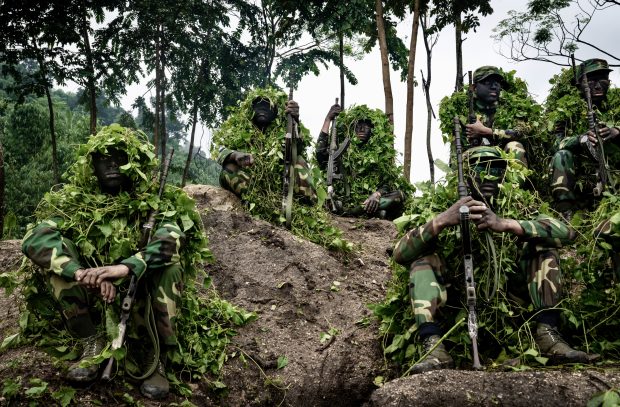Forging Genuine Unity amidst Deep Conflict in Myanmar: Prospects and Challenges
Shifts in the Strategic Landscape
Three years have passed since the Burmese military seized power through the coup. The backlash from society has crossed ethnic, religious, and geographic lines, sparking nationwide protests and resistance to a degree unseen in the country’s modern history. Over 17,000 instances of conflict have broken out between the military and resistance groups, and peaceful protests were met by violent crackdowns over 800 times. In waging this civil war, the military has launched over 1,600 air strikes and destroyed over 3,500 buildings and structures. Telephone and internet service has been cut off in 80 towns and cities. The human cost of this conflict is staggering: over 5,000 democracy activists and civilians have been killed by the military and its allies, and more than 2.7 million civilians have been forced to leave their homes.
In a sign of the coup regime’s weakening military strength, this past February the government enacted a compulsory conscription law applying to men between 18-35 years old and women between 18-27. Moreover, the government has also declared martial law in 55 of 330 districts across the country. Not surprisingly, these actions have only intensified popular opposition to the regime, particularly among young people.
The junta has lost significant amounts of territory over the past year to resistance forces. An alliance of three ethnic armed groups, calling themselves the Three Brotherhood Alliance (3BHA), launched a major campaign last October which seized control of hundreds of military posts from the coup regime. The 3BHA, made up of the Myanmar National Democratic Alliance Army, Ta’ang National Liberation Army, and Arakan Army, was able to take control of key trade zones in the eastern parts of the country along the border with China.
One month later, resistance organizations from the Karen ethnic group launched a major campaign in the southeastern part of the country along the border with Thailand which resulted in more regime losses. The People’s Defense Forces (PDF), made up primarily of young people from the Burman majority ethnic group, also played a major role in this operation. This was followed by an offensive launched in northern Myanmar by the Kachin Independence Army.
This nascent cooperation between different resistance groups has been unprecedented and brought about a major strategic shift in the balance of power between the regime and its opponents. Nevertheless, the goals and motivations of the various resistance groups are not necessarily fully aligned, which complicates the strategic landscape for anti-regime forces. Sustainable progress toward the vision of a true federal democratic future for Myanmar will require greater trust and consensus across all elements of the opposition movement.
Diverging Goals within the Opposition
For example, not long after the dramatic battlefield successes of the 3BHA’s October campaign (which has become known as “Operation 1027”), they agreed to a ceasefire with the military. Since then, the constituent members of the 3BHA have begun installing new governments over their newly acquired territories and creating de facto autonomous states without input from the civilian population. In March, they also agreed to share 30% of customs tax revenue collected with the military regime. If true, this would indicate that the 3BHA is not necessarily interested in overthrowing military rule, at least in the near-term.
When the 3BHA launched Operation 1027, there had been little prior communication with the National Unity Government (NUG), which is a government-in-exile that has played a leading role in the resistance to the military regime. The NUG has sought to build a broad coalition of both majority and minority ethnic groups with the goals of removing the military from power and implementing a federal democratic political system in Myanmar. The lack of coordination between the 3BHA and NUG seems to indicate that the 3BHA still does not fully trust the NUG.
Prospects of Effective Collaboration between Opposition Forces
In contrast, a campaign launched this past March illustrates the possibilities for fruitful cooperation between ethnic armed groups, the NUG, and civilian populations. Dubbed Operation 0307 after the March 7 date the campaign commenced, it involved a multi-pronged offensive against several junta bases in Kachin State, which is in the northern part of Myanmar near the border with China. The operation involved a coalition of armed forces from Myanmar’s ethnic minority communities (Kachin Independence Army, Kachin People’s Defense Force, and the Arakan Army), as well the NUG’s armed wing (People’s Defense Force) and a pro-democracy student organization (All Burma Students’ Democratic Front) made up primarily of the majority Burman ethnic group. The offensive successfully seized several strategic military outposts, dealing a significant blow to the military junta.
The close collaboration between the NUG and local resistance groups was driven by a shared goal of ending military rule and establishing a democratic government. Unlike Operation 1027, which saw significant intervention from the Chinese government to twist the arm of resistance groups to end the fighting which was harming Chinese economic interests, Operation 0307 remained free of Chinese influence and refused any negotiations with the military regime.
Another notable aspect of Operation 0307 was the active participation of local civilians in setting up new administrative structures in the areas captured from the military. This local involvement helped strengthen the alliance’s control and highlighted the strong partnership between the NUG and the resistance groups. The success of this operation has brought hope to many people in Myanmar, demonstrating that unity and collaboration can lead to significant progress against military rule.
The Need for Building Mutual Trust
The National Unity Government was formed to bridge the gap between various groups that emerged after the coup, including civil society organizations, resistance groups, and Ethnic Armed Organizations (EAOs). Shortly after its establishment as a government in exile, the EAOs began actively engaging with the NUG as key stakeholders in political and military matters. While this collaboration is a positive step towards the common goal of ending military rule, longstanding discrimination against ethnic groups by Burman rulers has made the EAOs hesitant to fully trust the NUG, which is predominantly Burman.
Understanding and overcoming these trust issues is crucial for achieving unity in Myanmar. There are two main challenges that need to be addressed to build genuine trust between the EAOs and the Burman majority:
1. Different Views and Vantage Points
More than 68 percent of Myanmar’s population are Burmans, and there has been systemic discrimination against ethnic minorities for decades by military rulers, who are also Burmans. Ethnic groups tend to focus on issues specific to their regions, while Burmans often take a broader, national perspective. This difference in political views and strong regional identities leads to frequent clashes, as Burmans attempt to address issues that ethnic groups feel are uniquely their own. It can be challenging for ethnic groups to understand the Burman perspective and vice versa. Recognizing and addressing these differing views is essential for building trust and collaboration towards a shared goal.
2. Discrimination
General Aung San, a revered national hero and founding father of modern Myanmar, played a crucial role in the country’s fight for independence from British colonial rule. In 1947, he established the foundation for modern Myanmar and called for equal rights, full autonomy, and the right to secede after ten years for the country’s ethnic minority groups. However, he was assassinated by political rivals and these promises were abandoned. Since then, a military junta has ruled Myanmar, enacting policies that have promoted the supremacy of the language, culture, and religion of the majority Burman population while discriminating against ethnic and religious minorities. This divide-and-rule tactic has stymied opposition forces for decades, and fostered an “us versus them” mentality between ethnic and religious communities.
To build genuine trust among Myanmar’s diverse population, it is imperative to tackle head on the legacy of ethnic and religious discrimination. Without trust and unity among people who have been divided for so long, the vision of a true federal democratic nation will remain out of reach.

Between March-April 2023, over 1,800 houses in 12 villages in the Shwe Ku region of Kachin State were destroyed by airstrikes, artillery barrages, and arson carried out by Military Division 88 of the coup regime. (Photo: Hkun Lat)

Members of the People’s Defense Forces, primarily made up of youths and pro-democracy activists, receive military training from the Kachin Independence Army, one of the major ethnic armed groups in Myanmar. (Photo: Hkun Lat)

